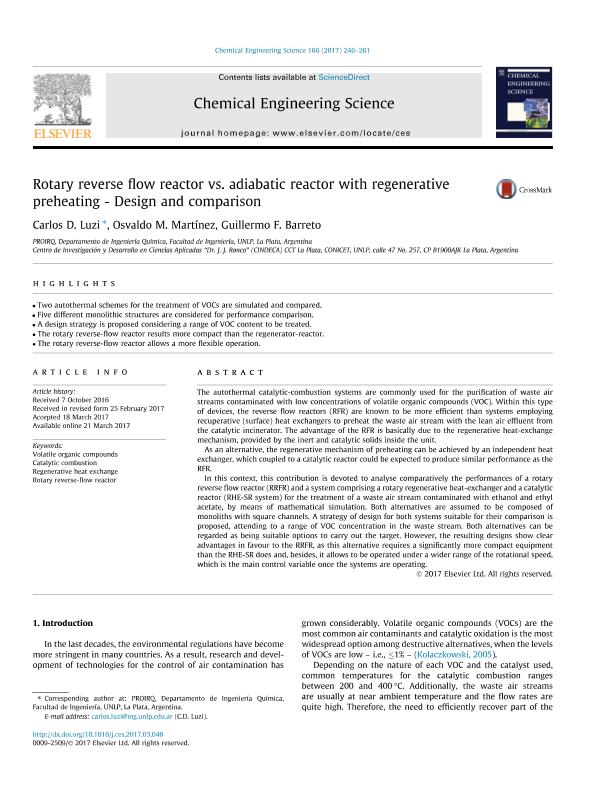Mostrar el registro sencillo del ítem
dc.contributor.author
Luzi, Carlos Daniel

dc.contributor.author
Martinez, Osvaldo Miguel

dc.contributor.author
Barreto, Guillermo Fernando

dc.date.available
2017-12-27T18:14:10Z
dc.date.issued
2017-03-21
dc.identifier.citation
Barreto, Guillermo Fernando; Luzi, Carlos Daniel; Martinez, Osvaldo Miguel; Rotary reverse flow reactor vs. adiabatic reactor with regenerative preheating: Design and comparison; Elsevier; Chemical Engineering Science; 166; 21-3-2017; 246-261
dc.identifier.issn
0009-2509
dc.identifier.uri
http://hdl.handle.net/11336/31682
dc.description.abstract
The autothermal catalytic-combustion systems are commonly used for the purification of waste air streams contaminated with low concentrations of volatile organic compounds (VOC). Within this type of devices, the reverse flow reactors (RFR) are known to be more efficient than systems employing recuperative (surface) heat exchangers to preheat the waste air stream with the lean air effluent from the catalytic incinerator. The advantage of the RFR is basically due to the regenerative heat-exchange mechanism, provided by the inert and catalytic solids inside the unit. As an alternative, the regenerative mechanism of preheating can be achieved by an independent heat exchanger, which coupled to a catalytic reactor could be expected to produce similar performance as the RFR. In this context, this contribution is devoted to analyse comparatively the performances of a rotary reverse flow reactor (RRFR) and a system comprising a rotary regenerative heat-exchanger and a catalytic reactor (RHE-SR system) for the treatment of a waste air stream contaminated with ethanol and ethyl acetate, by means of mathematical simulation. Both alternatives are assumed to be composed of monoliths with square channels. A strategy of design for both systems suitable for their comparison is proposed, attending to a range of VOC concentration in the waste stream. Both alternatives can be regarded as being suitable options to carry out the target. However, the resulting designs show clear advantages in favour to the RRFR, as this alternative requires a significantly more compact equipment than the RHE-SR does and, besides, it allows to be operated under a wider range of the rotational speed, which is the main control variable once the systems are operating.
dc.format
application/pdf
dc.language.iso
eng
dc.publisher
Elsevier

dc.rights
info:eu-repo/semantics/openAccess
dc.rights.uri
https://creativecommons.org/licenses/by-nc-sa/2.5/ar/
dc.subject
Catalytic Combustion
dc.subject
Regenerative Heat Exchange
dc.subject
Rotary Reverse-Flow Reactor
dc.subject
Volatile Organic Compounds
dc.subject.classification
Otras Ingeniería Química

dc.subject.classification
Ingeniería Química

dc.subject.classification
INGENIERÍAS Y TECNOLOGÍAS

dc.title
Rotary reverse flow reactor vs. adiabatic reactor with regenerative preheating: Design and comparison
dc.type
info:eu-repo/semantics/article
dc.type
info:ar-repo/semantics/artículo
dc.type
info:eu-repo/semantics/publishedVersion
dc.date.updated
2017-12-19T18:47:38Z
dc.journal.volume
166
dc.journal.pagination
246-261
dc.journal.pais
Países Bajos

dc.journal.ciudad
amsterdam
dc.description.fil
Fil: Luzi, Carlos Daniel. Consejo Nacional de Investigaciones Científicas y Técnicas. Centro Científico Tecnológico Conicet - La Plata. Centro de Investigación y Desarrollo en Ciencias Aplicadas ; Argentina
dc.description.fil
Fil: Martinez, Osvaldo Miguel. Consejo Nacional de Investigaciones Científicas y Técnicas. Centro Científico Tecnológico Conicet - La Plata. Centro de Investigación y Desarrollo en Ciencias Aplicadas ; Argentina
dc.description.fil
Fil: Barreto, Guillermo Fernando. Consejo Nacional de Investigaciones Científicas y Técnicas. Centro Científico Tecnológico Conicet - La Plata. Centro de Investigación y Desarrollo en Ciencias Aplicadas ; Argentina
dc.journal.title
Chemical Engineering Science

dc.relation.alternativeid
info:eu-repo/semantics/altIdentifier/doi/http://dx.doi.org/10.1016/j.ces.2017.03.046
dc.relation.alternativeid
info:eu-repo/semantics/altIdentifier/url/http://linkinghub.elsevier.com/retrieve/pii/S0009250917302130
Archivos asociados
